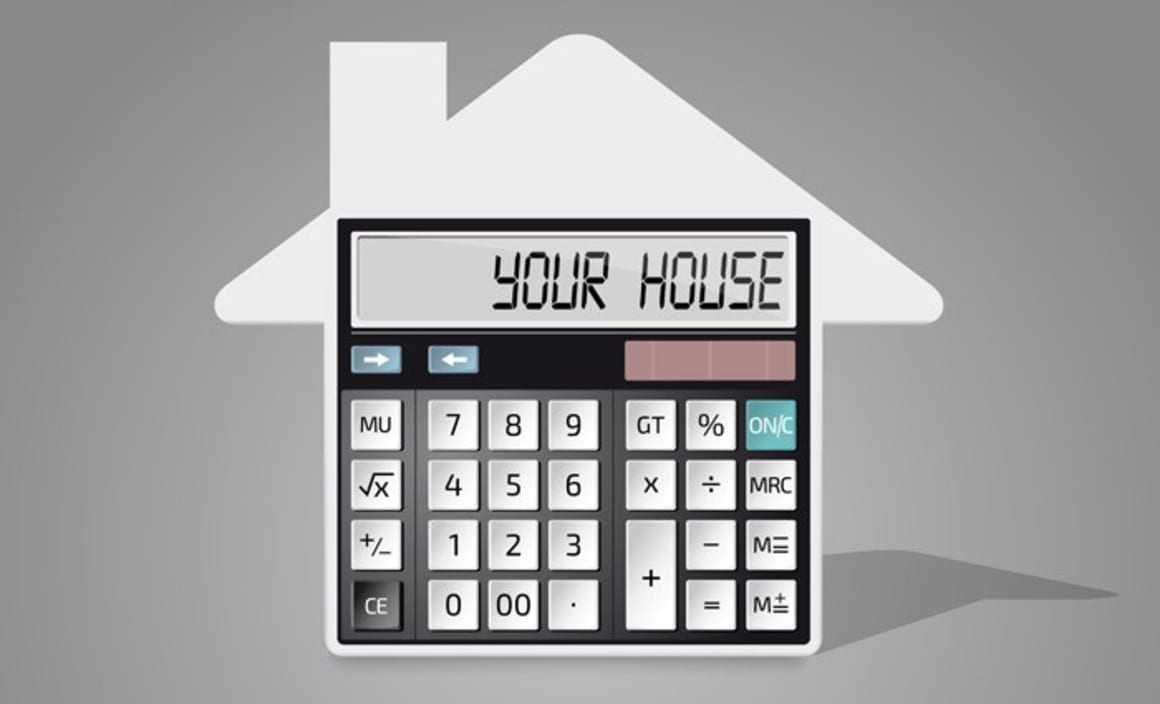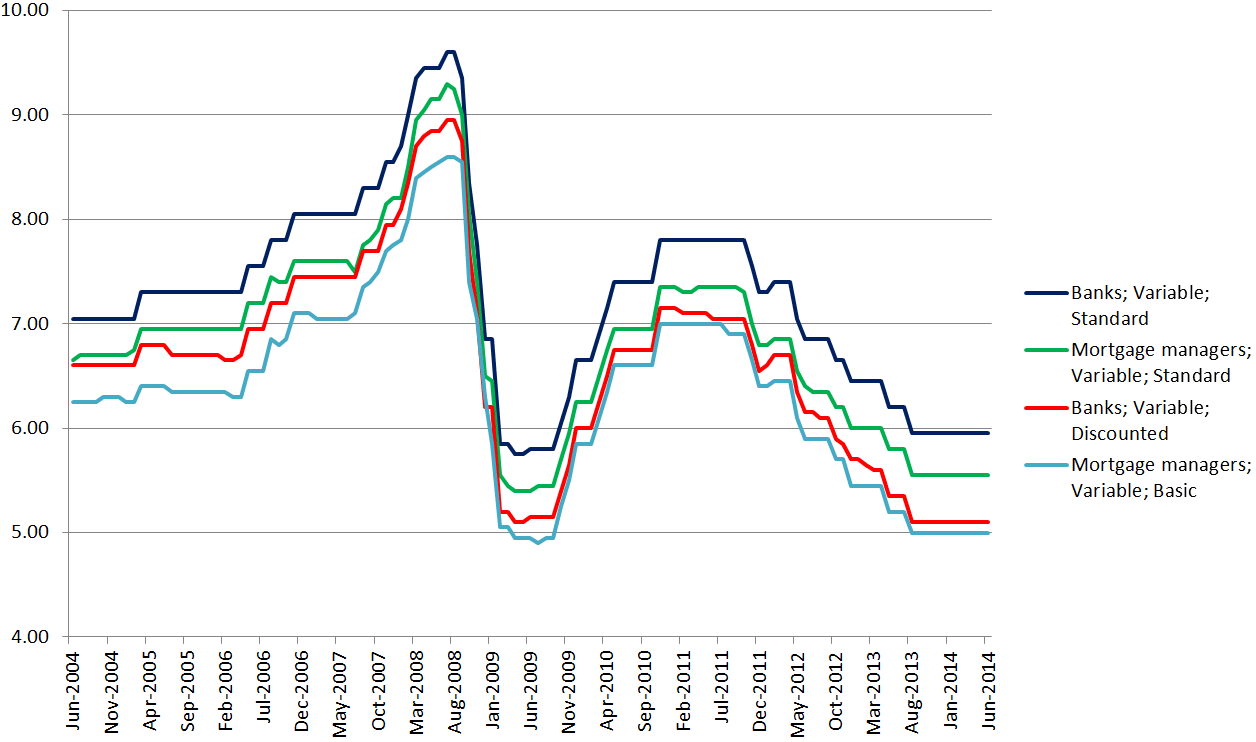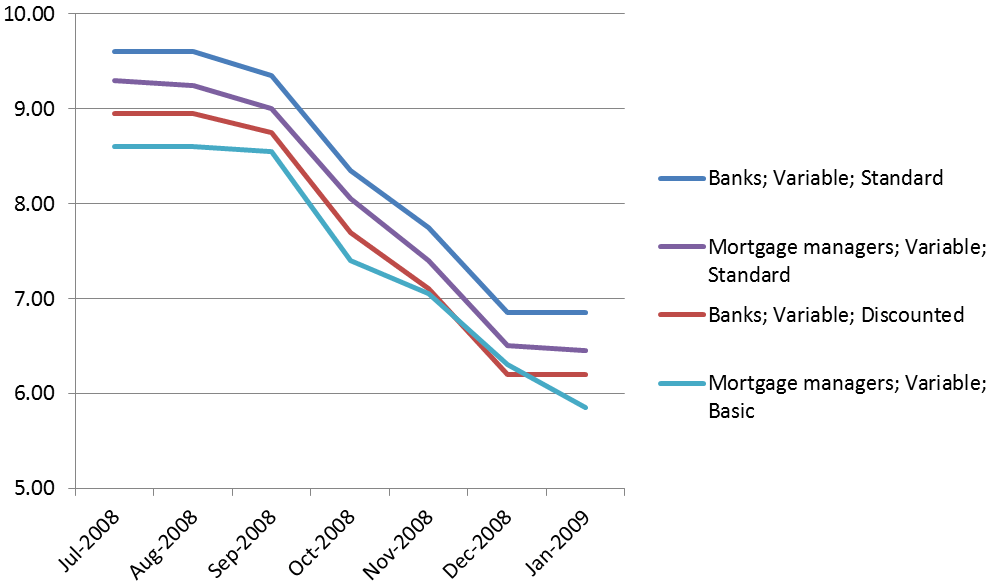What the RBA's indicator rates can tell you about your home loan

The Reserve Bank of Australia publishes a number of different indicator lending rates each month.
These include indicator rates for home loans issued by banks and mortgage managers, as well as personal loans and loans to large and small businesses.
Indicator rates for home lending are published for standard variable loans from banks and mortgage managers; discount variable loans from banks; basic variable rate loans from mortgage managers and three-year fixed interest rate loans from banks.
As the chart below shows, of the variable interest rates offered by lending institutions standard variable loans offered by banks generally have the highest indicator lending rate. Mortgage managers’ standard variable rate loans are next highest, followed by banks’ discount variable rate loans, with mortgage managers’ basic variable rate loans having the lowest interest rates.
Chart 1: Indicator lending rates over the decade 2004-2014

Source: Property Observer using RBA data
Canstar research manager Mitchell Watson says lenders use the standard variable indicator rate as a reference rate when issuing discounts on mortgages to customers.
Few people pay the standard variable indicator rate. Most consumers will pay around 0.7 percentage points less than that rate, either through a packaged loan which offers a discount rate, or through a basic home loan, Watson says.
Consumers interested in home lending rates should look at the RBA’s indicator rates for bank discount variable loans, mortgage managers’ basic variable loans and bank three year fixed rate loans when comparing products.
“What they provide is an indication of the type of interest rates that you should be looking for,” Watson says. “That should be a benchmark if you are researching or looking to take out a home loan.”
Lenders offer two main types of variable-rate mortgage products: basic loans and packaged loans.
“A basic home loan is a product that doesn’t have all the bells and whistles. It may not have an offset account and if you want to access certain features it might cost to do that,” Watson says.
“A discount [variable rate mortgage] will have an offset account and all the bells and whistles but also attract a higher annual fee.”
The rates the RBA publishes are an average. Watson says there will be lower rates available, so it pays to shop around.
Fully featured discount variable rate loans tend to be slightly more expensive than basic home loans, but that is not always the case. During the financial crisis the indicator rate for home loans from banks briefly fell below the indicator lending rate for mortgage managers’ basic variable loans (see chart below).
Chart 2: Detail from Chart 1

Source: Property Observer using RBA data (detail from Chart 1)
Watson says that was most likely due to interest rate cuts at the time being passed on more quickly on discount variable rate loans than on mortgage manager basic rate loans.
While movements in the RBA’s cash rate direct mortgage interest rate changes to some extent, lenders often lower or raise the mortgage rates they offer on their products independently of the RBA’s interest rate movements.
In late July, the country’s biggest banks cut rates on five-year fixed mortgages, despite there being no change from the RBA.
The Commonwealth Bank, National Australia Bank and Westpac all cut five-year fixed rate loans to less than 5%. NAB also cut its four-year to 4.99% and its three-year loan to 4.94%.
Smaller lenders followed quickly. Last week, St George cut its rates to 4.99% for four and five year loans under its Advantage package. ME Bank and RAMS also dropped their fixed rates below 5%.
Watson says the banks have been able to offer lower rates to customers as their lending costs – which are determined by factors such as the outlook for the RBA cash rate – have fallen.
Finder.com.au money expert Michelle Hutchison says in the past, when lenders lowered the rates on their fixed loan products, it was a good indication that variable rates would soon be cut too. But now, most interest rate experts believe the next rate movement will be up, according to Finder.com.au’s monthly survey of economists.
The recent mortgage rate cuts are likely to be part of a competitive push by lenders to lock in customers for a longer period of time, Hutchison says.
“The longer the bank can lock you in to a home loan the better it is for the bank,” she says. “Often fixed home loans have limitations and caps on how much you can repay in lump sums. Also, there are break costs if you want to break within the fixed period so if you fix the loan as a borrower you are likely to stay in that loan for at least that fixed period.”
Consumers can more easily change mortgage products than in the past due to the banning of early exit fees on variable rate mortgages in 2011, Hutchison says. That has encouraged banks to take steps, such as offering very low five-year fixed rates, to lock in customers.
Finder.com.au has calculated that with the average variable rate at around 5.5%, the low five-year rates available will offer considerable savings to many borrowers. According to their calculations, variable rates would need to be cut by 25 basis points every six months for the next four and a half years before rising again – a total of 125 percentage points of cuts – for a variable rate mortgage to cost less than the fixed rate loans.
But five-year fixed rate loans will not suit everybody, Watson says.
“The big thing to consider is the term. Understand that big changes in your financial situation might have an impact on what’s the best term for you. If you are looking to upgrade in four years time, a five-year fixed term may not suit you due to break costs,” Watson says.
People who wish to repay a fixed-rate loan in full before the end of the term typically have to pay a fee called a break cost. This can be very high depending on factor such as how much of the term is left to run.
Fixed rate loans also tend to have fewer features than variable rate loans, although Watson says fixed rate mortgages with offset accounts and facilities to allow extra repayments are becoming more common. CUA, Mortgage House and ANZ for example, have fixed rate loans with some of the same features traditionally offered only by a variable rate loan.